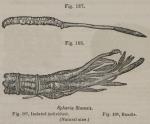 Hia Tsao Tom Tchom, Reaumur, Mém. de l'Acad. des Sc. 1726, p. 302, tab. 16; Hia Tsao Tong Tchong, Du Halde, Descr. Géogr. et Hist, de la Chine, vol. iii. p. 490, 1770; Totsu Kaso, Thunberg, Travels in Europe, Asia, &c. between 1770 and 1779, vol. iii. p. 68; Hiastaotomtchom, Rees's Cyclop.; Tong Chong Ha Cho, Reeves; Summer-Plant-Winter Worm, Pereira, Pharm. Journ. vol. ii. p. 590, 1843; Hea Tsaou Taong Chung, Westwood, Ann. of Nat. Hist. vol. viii. p. 217; Sphaeria Sinensis, Rev. M. J. Berkeley, in Hooker's Lond. Journ. of Botany, vol. ii. p. 207, 1843.
Hia Tsao Tom Tchom, Reaumur, Mém. de l'Acad. des Sc. 1726, p. 302, tab. 16; Hia Tsao Tong Tchong, Du Halde, Descr. Géogr. et Hist, de la Chine, vol. iii. p. 490, 1770; Totsu Kaso, Thunberg, Travels in Europe, Asia, &c. between 1770 and 1779, vol. iii. p. 68; Hiastaotomtchom, Rees's Cyclop.; Tong Chong Ha Cho, Reeves; Summer-Plant-Winter Worm, Pereira, Pharm. Journ. vol. ii. p. 590, 1843; Hea Tsaou Taong Chung, Westwood, Ann. of Nat. Hist. vol. viii. p. 217; Sphaeria Sinensis, Rev. M. J. Berkeley, in Hooker's Lond. Journ. of Botany, vol. ii. p. 207, 1843.
This remarkable production is a highly esteemed article of the Chinese Materia Medica. It consists of a caterpillar or larva of a lepidopterous insect (probably a species of Agrotis), from whose neck projects the fungus, called by the Rev. M. J. Berkeley, Sphaeria Sinensis.
Sphaeria, Fries. Peritheda rounded entire, furnished at the apex with a minute orifice. Asci converging, at length dissolving.
S. Sinensis, Berkeley. Brown; stem cylindrical, somewhat thicker downwards; head cylindrical, confluent with the stem, pointleted.
Du Halde says that it is produced in Thibet, and also on the frontiers of the province of Se-tchuen, which borders on Thibet, or Laza. It is brought to Canton in bundles tied up in silk (see Fig. 188): each bundle containing about one dozen individuals.
Each individual (see Fig. 187) is about three inches long, half being the caterpillar; the other half projecting from the back of the neck is the club shaped fungus, attached by slender filaments, which spread over the surface of the larva. The substance of the caterpillar is replaced by a mass of fine branched threads, mixed with globules of oil. In none of the specimens examined by Mr. Berkeley were the perithecia developed.
In China, it is reputed as a strengthening and renovating substance, and is supposed to possess properties similar to those ascribed to ginseng. It is recommended in cases where the powers of the system have been reduced by over-exertion or sickness. But on account of its scarcity it is only used in the palace of the Emperor.
The mode of employing it is curious. The belly of a duck is to be stuffed with five drachms of this fungus, and the animal roasted by a slow fire. The virtue of the fungus is supposed to pass into the flesh of the animal, which is to be eaten twice daily for eight or ten days!

